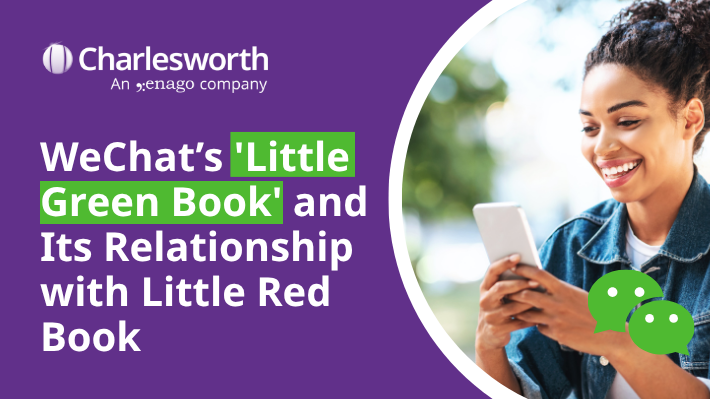WeChat’s ‘Little Green Book’ and Its Relationship with Little Red Book: Competition or Coexistence

China’s social media landscape is constantly evolving, with platforms launching new features to stay relevant. One of the latest developments is WeChat’s “Little Green Book,” which has sparked discussions about whether it could challenge the established Little Red Book (also known as Xiaohongshu or RedNote).
Little Red Book is a lifestyle-focused platform, highly popular among young, urban women, offering content on fashion, beauty, and personal experiences. It has built a reputation as a go-to platform for authentic recommendations, with users sharing their personal journeys with products and trends. The platform’s authenticity is further enhanced by its strict community guidelines, which discourage overly promotional content and encourage genuine user experiences.
In contrast, WeChat’s “Little Green Book” adopts a similar layout but differs in how content is created and consumed. Given WeChat’s massive reach, the impact of “Little Green Book” could be significant, but does it truly compete with Little Red Book? Let’s explore the key differences.
Content Creation: Personal vs. Professional
The way content is generated on both platforms is fundamentally different. This difference in content creation also affects how users perceive and interact with the content on each platform.
- Little Red Book: Content is driven by users who share personal experiences, product reviews, and lifestyle tips. It feels authentic and relatable, making it highly engaging. The posts often include user-generated photos, detailed captions, and honest opinions. This fosters a strong community where people trust each other’s recommendations.
- Little Green Book: Content comes mainly from media accounts, making it more like an information hub. Articles are curated and resemble digital magazine features rather than personal stories. This structure gives it a more professional and news-like feel, but it also means the personal touch is less evident.
Example: On Little Red Book, a user might post a review of a new skincare product, sharing their before-and-after photos and personal experience, detailing how it worked for their skin type. On Little Green Book, the same product might appear in a media-generated article summarising its benefits based on official sources, making it more like a traditional product highlight rather than a firsthand review.
User Engagement: Community vs. Broad Appeal
Engagement methods differ greatly between the two platforms. The engagement model on each platform also influences the type of content that gains popularity and the dynamics between content creators and consumers:
- Little Red Book: Uses a voting system where users engage by liking and commenting, which helps quality content rise organically. The algorithm favours content with higher engagement, allowing niche topics to find the right audience. This democratic approach enables organic growth, fostering trust between content creators and followers.
- Little Green Book: Serves a much larger and diverse user base, making it harder to tailor content to specific interests. As a result, content may feel more general and less personal. Since WeChat already includes various types of media consumption, “Little Green Book” is just another layer within the larger ecosystem, which could dilute its impact in comparison to the focused engagement of Little Red Book.
Strategic Impact: Competition or Coexistence?
Rather than competing directly, WeChat’s “Little Green Book” seems to be an attempt to follow social media trends. Since WeChat serves a much broader audience, its feature is unlikely to replace Little Red Book’s niche community. Instead, both platforms cater to different user needs and can exist alongside each other. For brands, this means that a well-rounded strategy might involve using Little Red Book for authentic, community-driven engagement and WeChat’s ‘Little Green Book’ for broader, information-based outreach.
Key Factors in Strategic Impact:
- Audience Demographics: Little Red Book is predominantly used by young women who are passionate about beauty, fashion, and lifestyle. WeChat’s “Little Green Book” targets a much broader audience, including professionals and media consumers who might not be as focused on personal experiences.
- Content Longevity: Posts on Little Red Book can gain traction over time through search algorithms, whereas WeChat content is often consumed in the moment before being overshadowed by newer updates.
- Monetisation and Influencer Culture: Little Red Book has established influencer marketing, with brands actively collaborating with users for promotions. WeChat’s “Little Green Book” lacks this deep-rooted influencer culture, making its content more informational than persuasive.
Comparison Chart: Little Red Book vs. Little Green Book
| Feature | Little Red Book (Xiaohongshu) | WeChat’s Little Green Book |
| Content Type | Personal stories, reviews | News-like, curated content |
| Creators | Individuals, influencers | Media accounts, publishers |
| User Base | Niche, lifestyle-focused | Large, general audience |
| Engagement | Likes, comments shape visibility | Broad audience, less personalised |
| Experience | Community-driven, interactive | Informative, less personal |
| Monetisation | Strong influencer culture | Primarily media-driven content |
| Searchability | Evergreen content finds new users | Timely, short-lived content |
Conclusion
While “Little Green Book” is a notable addition to WeChat, it does not pose a direct threat to Little Red Book. The two platforms serve different purposes—one fosters personal storytelling, while the other acts as a digital information hub.
Brands and content creators that recognize these distinctions can effectively leverage both platforms to reach diverse audiences and achieve their marketing objectives in China’s competitive digital market.
Little Red Book thrives on trust, with real users sharing honest experiences, whereas “Little Green Book” operates more like a news aggregator. As China’s social media continues to evolve, both platforms will likely coexist, each catering to its unique audience. Understanding these differences is crucial for brands and content creators who want to navigate these platforms effectively. Instead of replacing one another, these platforms highlight the diverse ways in which Chinese social media users consume and engage with content.
At Charlesworth, we understand the complexities of marketing across different Chinese social media platforms. Our expertise allows brands to develop tailored strategies for both Little Red Book and WeChat’s Little Green Book, ensuring they reach the right audience with the right message. Whether you’re looking to build authentic engagement on Little Red Book or leverage WeChat’s broad user base for informative content, our team provides strategic insights and content solutions that help brands thrive in China’s digital ecosystem. By carefully analysing audience behaviour and content trends, Charlesworth helps businesses expand their presence, ensuring long-term growth and success in the competitive Chinese market.


